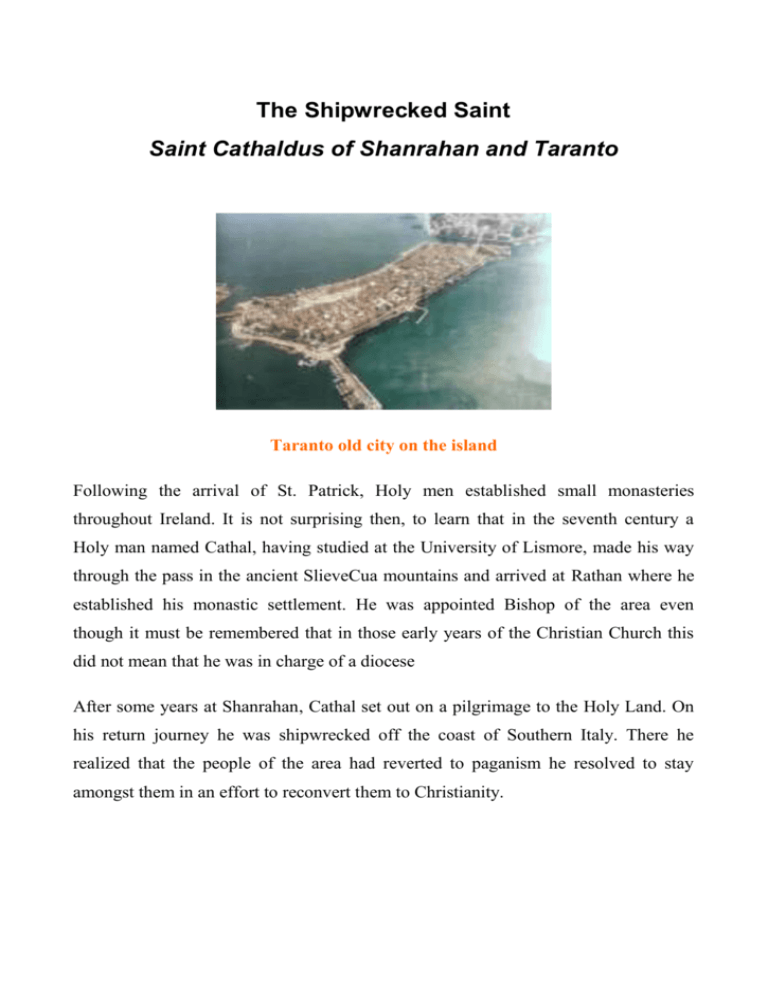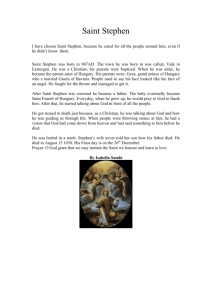The Shipwrecked Saint
advertisement

The Shipwrecked Saint Saint Cathaldus of Shanrahan and Taranto Taranto old city on the island Following the arrival of St. Patrick, Holy men established small monasteries throughout Ireland. It is not surprising then, to learn that in the seventh century a Holy man named Cathal, having studied at the University of Lismore, made his way through the pass in the ancient SlieveCua mountains and arrived at Rathan where he established his monastic settlement. He was appointed Bishop of the area even though it must be remembered that in those early years of the Christian Church this did not mean that he was in charge of a diocese After some years at Shanrahan, Cathal set out on a pilgrimage to the Holy Land. On his return journey he was shipwrecked off the coast of Southern Italy. There he realized that the people of the area had reverted to paganism he resolved to stay amongst them in an effort to reconvert them to Christianity. St. Cataldo Within a few years the people of Taranto in Southern Italy had selected Saint Cataldo (in Latin, Cathaldus or Cataldus) as their Bishop. Today the popularity of Saint Cathaldus in Southern Italy is equal too, if not greater than, the popularity of St. Patrick in Ireland. Over one hundred and fifty churches are dedicated to him in this country and the Cathedral-Basilica in Taranto proudly bears his name. He is the Saint Protector of many other places in Italy. A town in Sicily is called San Cataldo. Cathedral of Saint Cataldo, Taranto, Italy Restructured, modified and burnt down several times through the centuries, the cathedral has a baroque facade of the early XVIIIth century. The baptismal font is surmounted by a XVIth century canopy. The impressive interior is characterized by a wide navy and two aisles supported by marble columns that are decorated by carved capitals (Romanesque, Arab, Bizantine, Longobard style). The floor still keeps some remains of its original mosaic paving. The central nave is covered by a beautiful wooden coffer ceiling from the XVIIth century. At the interior the attention is attracted by the transept and the cupola. They belonged to a bizantine church of the Xth and XIth century which was latinized in 1170. The cathedral contains an interesting crypt, under the High Altar, which has bizantine frescoes of the XIIth century. The outstanding chapel of San Cataldo is a blooming collection of inlaid marbles, statues and frescoes of the end of XVIIIth century. The imposing altar holds the bones of San Cataldo and a silver statue of the Patron. In 1071, during the reconstruction of the Basilica in Taranto, the tomb of Cathaldus was discovered and opened. With his body was found a gold cross bearing his name and the word Rathcau. Baroque façade and a ceiling fresco










